Rishad Tobaccowala's Blog, page 7
October 20, 2024
Modern Leadership.

Image by Almosthumankreative using Midjourney.
We have entered an age of de-bossification.
In many industries, particularly “White-collar” ones, the era of “bosses” is in decline.
Less of a clamoring for bosses, managers, controllers, monitors, evaluators, and paper pushers.
This shift has been driven by changing demographics, the spread of technology, the rise of unbundled and distributed work, new behavior expectations, and a re-definition of what “work” is including the rise of fractionalized and free-agent talent who work for themselves or at multiple jobs and are expected to comprise most of the workforce in the US by the end of the decade.
There is a rise in the need for leaders, guides, coaches, mentors, role-models, creators, and builders.
Leaders matter like never before but what are the characteristics of such leaders and how do we build such skills?
A long time colleague Drew Ianni and myself were very fortunate in having one hundred leaders convene in New York over one and a half days to listen to each other and begin to work together on how to best to identify, craft, discuss and enhance modern leadership skills at the inaugural salon of The Athena Project.
Ten Insights to Modern Leadership.Every one of us can be a leader since it is a way of being and behaving while a boss is a title and requires having people reporting to them.
Many bosses are great leaders but leaders do not need to be bosses.
Leaders focus on zones of influence versus fixating on zones of control.
Leaders build wide spectrum skills versus just being full-stack. They have wide and broad horizons.
In a world of change and connections the best leaders recognize that mastery of craft alone will not be enough to navigate the complexity of leadership.
Leaders have courage. If one goes with the flow or just follows the number there is really no need for the individual.
Trust is and always will be the key currency for leaders. Today only 10 percent of CEO’s trust their CMO’s.
The best leaders are always learning and growing but never grow up. They feed not just their mental operating systems but also their physical and emotional operating systems.
Leaders recognize that companies do not transform but people do and they need to transform themselves. But transformation is a process of transition and the best leaders are managing many transitions both of their firms, the people around them and themselves.
Today's leaders think of growth in many more ways than just growing their business or focusing only on their firms. Optionality is freedom. They want to grow their own influence whether it be writing, speaking, other boards and planing for a non company career. They wish to grow their own intelligence in many areas not just focussed on things like AI but also Private Equity, Cultural Trends to be impactful in a multitude of ways. Almost everyone is thinking about how to manage a portfolio career in a world that is in transition.
Transforming from boss/manager to leader/coach is possible for those wishing to try.As times change the best managers adapt and learn and flex into new shapes and learn new skills.
This transformation requires three conditions:
First it requires today’s bosses to accept that to grow and remain relevant they will have to change and while it may be difficult it is better than becoming irrelevant.
It also requires their leaders to ensure that new incentive systems that are more about zones of influence, growth of craft and people versus zone of control of budgets and team size are put into place.
There is an urgent need for coaching and training and patience to help today’s managers become tomorrow’s leaders.
A personal hunger supported by new incentives and buttressed with training including the opportunity to self-learn is the formula.
Talent is short and many leaders are aware of this and planning accordingly.
They know that new brooms sweep clean but old brooms know the corners.
October 13, 2024
Becoming You.
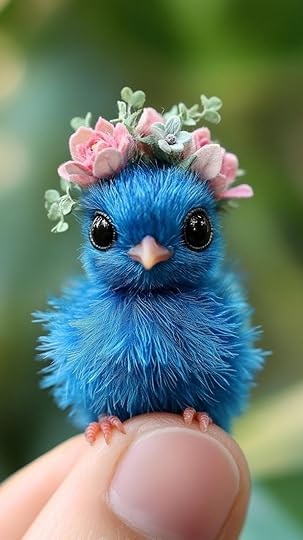
While it is important to listen to and learn from other people and be aware of what they may think of us, we should not live in other peoples minds.
Worrying about how we will be perceived or how we compare and measure up to others is like handing over the remote control of our life to someone else.
The more we ask what will they think, how will we look, and let every driver of our success and decision making come from external perception and extrinsic measures rather than internal introspection and intrinsic measures , the more likely we end up not achieving our true potential or peace of mind.
Many of the people we admire go against the way they should behave and question the status quo.
Galileo questioned whether the earth was at the center of the Universe.
Picasso invented new forms like Cubism that collapsed and re-expressed the rules.
Steve Jobs asked us to “Think Different”.
The key with these rule breakers is not that they broke rules and were fixated on just being different or not caring what others thought but that they were builders creating things that transformed and positively impacted the world of science, art, business and technology.
They did not tear down society or other people but rather got the world to see, think and feel differently.
They were about breaking rules in ways that empower, that open new horizons and drive growth.
They became themselves.
But while few can be like these giants we can all self-empower, set off toward new horizons and transform and grow ourselves by not letting external rulers drive our lives.
We can learn to compete with our elves and get better every day, versus competing with others or aligning with the changing fashions and expectations of others.
Let’s not be born as originals and die as copies.
It’s important to become who we are.
One way of doing so is to architect, sculpt and hone.
 Architect.
Architect.“The way we spend our time defines who we are.” Jonathan Estrin.
One way to gain control is to architect one’s week in ways that time and its vagaries do not toss us around.
Consider setting aside an hour a day or seven hours a week to feed each of one’s physical, mental, emotional systems.
Physical operating system: A long walk or exercise.
Mental operating system: Learn or read or watch or do.
Emotional operating system: Connecting with friends and family. Helping others.

Image using Midjourney by Osoyoi
Sculpt.“Every block of stone has a statue inside it, and it is the sculptor’s job to release it” Michelangelo.
Every individual has one or more talents, and it is our job to find, feed and sculpt these talents.
Today we are increasingly in a world of builders, makers, creators, inventors and in sculpting something special out of raw materials is a way to find flow and make and leave one’s mark.
It may be writing or photography or video or writing code, cooking a meal, investing in a relationship, building a company or many other things but transforming and building is both an anti-dote and a homage to a transforming world.
We transform and are not just transformed.
Build things. Make stuff. Create something .Unleash potential.
We can release the statue within us or help others find the statue within them.

Image using Midjourney by Mikie555
Hone.“To hone my voice, I read everything, from books to cereal boxes, three times: once for fun, the second time to learn something new about the writing craft, and the third time was to improve that piece.” Amanda Gorman
In a world of change we must hone ourselves to align with change since change does not care to adjust to us.
Honing through iteration, learning, re-inventing, and many other ways of enhancing excellence of craft.
For many of us in the coming years it will be how to incorporate, build on, extend, and leverage AI as a tool, enabler, extender, and idea generator for our work.
October 6, 2024
Organizational Misfit.

The future organization does not fit in the containers or the mindsets of the past.
Until around January 2020, most companies operated under the following five assumptions or beliefs:
1. The organization gives structure and directs work.
2. Tenure and experience are critical to advancement.
3. Most of the work is done inside an organization.
4. Fairness requires a common set of rules and ways of working that apply to all.
5. Most people are full-time employees of the company.
Here are beliefs that have already begun to replace current beliefs and will by the end of this decade completely supplant these traditional ones:
1. The organization enables talent to create structure and direct work.
2. Expertise and constant learning in a changing world are more highly valued than tenure/experience.
3. Most of the work is done outside an organization by suppliers and by accessing talent as needed.
4. Fairness means customizing programs for each talent and giving everyone equal access to those programs.
5. Most staff are either contract workers, freelancers, or fractionalized employees.
Because of these new beliefs and assumptions, organizations must rethink how they design everything, from compensation systems to decision-making processes.
Dump the charts!To create a redesign that is effective now and for years to come, we need to think about structure more broadly than is typical. Most people think of business structures from an organizational-chart perspective. They envision boxes and connecting lines that indicate who reports to whom or the flow of goods and services from the company to various markets. That’s why when people talk about restructuring, they focus on things like flattening the organization and eliminating some of the lines or streamlining the supply chain.
While all of this is important, it’s just part of what needs to be redesigned. An organizational chart is a two-dimensional view—I’m advocating a three-dimensional redesign.
For years, we’ve fooled ourselves into believing that the organizational chart represents how the organization works. That was okay in less complex, less volatile times, but it’s no longer acceptable. Consider that organizational charts and maps indicate how leaders want the company to operate, but the reality often is quite different.
For instance, the maps and charts document zones of control rather than zones of influence. A title represents a position that may be vested with authority but not necessarily the authority to determine how work is done. These charts also impose clarity where there often is none. Business is messy, and operations often shape-shift based on circumstance, ignoring the flowchart. The official organizational structures are also limited in scope, failing to account for all the external partners, freelancers, and other outside groups that have become necessities.
Consider the static nature of organizational design, driven by internal factors (that is, areas of expertise) and client/customer categories. In an increasingly globalized world filled with new marketplaces and transformed by technology, this design must be more organic, adapting to external stimuli.
Tenets of organizational design.On the most basic level, it means they must design structures from the outside in rather than the inside out. In a fast-changing world, companies must create their processes and procedures based on marketplace realities (that is, emerging competitors and changing talent mindsets) rather than relying on “the way things have always been done around here.”
They should also embrace multiple models of working rather that a single model. Given the multiplicities in workplaces today, models need to differ based on country, competition for talent, and whether the focus is on current business or innovations.
And finally, it means outcomes and goals take precedence over process and control.
Financial results, customer satisfaction, and talent attraction/retention should take priority over following strict procedures or maintaining tight control about how work is done.
Design discussed as a singular object is a mistake. Plural designs make a lot more sense.
For this reason, redesigning the structures must take the following factors into consideration:
Customer benefit. This may seem obvious, but company design often reflects internal requirements first and customers second. Given the increasing diversity and changing needs of customers, organizations should consider creating different designs for different customers. This might mean co-locating with a customer or integrating with customer suppliers
Talent advantage. In the past, points of differentiation included price, service, innovation, and so on. Today, the main differentiator is talent. Companies must organize in ways to ensure that their talent is satisfied and growing. Considering that talent often is spread across different locations, possesses different work-style preferences, and represents a wide demographic range, one organizational model doesn’t fit all. Instead, the model should accommodate the full range of talent.
Change adaption. The previous two points allude to this one: organizational design must be flexible, able to shift as changes occur. Competitors change. Laws change. Markets change. The design, therefore, must anticipate that these shifts will occur and be created in such a way that adapting a policy or revamping a process isn’t a big deal. This is an organic, evolving approach to design (versus an artificial, static one). To deliver on strategy, one needs to update the design continuously.
Permeability. Traditional designs are closed systems. Today, they need to be open. They must be capable of connecting and fusing with other companies in an increasingly con- nected, fast-moving world. A company and its deliverables grow by combining capabilities and products from different external firms or being part of those other firms’ deliveries.
Trust a key to Organizational Re-design.To commit to this type of redesign requires trust—management must trust talent and teams to determine the best ways to drive financial results, customer satisfaction, and talent attraction and retention. By restructuring roles, talent takes the initiative while management guides and coaches.
This trust extends to empowering teams to solve problems and capitalize on opportunities in ways that make sense for their markets (rather than everyone following the mandate from headquarters). Management’s restructured role involves setting parameters—they grant their people freedom within a framework. They know where the guardrails should be erected to prevent teams from getting in legal difficulties or taking unreasonable risks.
Is your organization biased toward yesterday or tomorrow?While many organizations have taken steps in this direction, most are not there yet. To assess redesign progress, the following questions might help:
Does your company possess agile systems and processes? Is it flexible when it comes to how and where work is done and how partnerships are initiated?
Can you deliver customized products and services? Does your organizational structure support personalization or is one particular system or process mandated?
Are the policies and protocols of your organization designed to facilitate trust among teams and customers?
This is a an extract from 2 pages of a chapter called Redesign the Structures from Rethinking Work which has been called “that rare book that simultaneously helps you look at the world, your work, and your life in new ways.”
CEO’s, Deans of Schools, Heads of Talent who have had access to the book believe it is the most comprehensive, yet distilled, highly realistic and yet future forward take to every aspect of work from strategy to talent to technology to financials. Available for pre-order. Turbocharge your career, unleash your teams and reinvent your company’s tomorrow! Learn more here.

September 29, 2024
Thriving in the Long Run.

Successful individuals and firms tend to have a commonality to their success.
Behaviors that unite them regardless of country, industry or culture they operate in.
Things that allow them to thrive consistently over long run
They all display a sense of perspective, an ability to be perceptive, a constant hunger to pioneer and a dogged constant persistence.
Perspective: With time and experience comes a sense of perspective.
An understanding that the world does not revolve around oneself or the firm.
This allows one to become more empathetic, generous and invest in relationships.
Relationships for the long run.
A sense of perspective also brings with it the realization that life and career while in one way are short in other ways they span decades and will bring a tangle of good and bad, ups and downs. To succeed one needs to grimace and march on in the bad times while not losing all sense of proportion and propriety when the force appears to be with us.
Perspective is also important to companies, so they see where they fit in their eco-systems and can determine both who to partner with but also to visualize their category broadly enough to see opportunities and threats outside a narrow slice of geography, time, or market.
Successful people and firms also put things in perspective when explaining and making their case. They place things in historical or other frameworks to build convincing stories.
Perceptiveness: The Cambridge dictionary defines someone who is perceptive as one who is “very good at noticing and understanding things that many people do not notice”.
This noticing and understanding can be about being emphatic in how one deals with people or seeing a niche or hiccup in a process that many may miss or to be self-aware of one’s weaknesses and mental models.
Today we live in a connected, collaborative world where people are looking for customized solutions. While data informs, insight and the wisdom are extracted by the perceptive.
Perception can be honed and grown and will be a key for success as it will be what helps differentiate carbon based analog feeling individuals from increasingly powerful silicon based digital computing machines.
Perception means being close to customers and market trends and to pay attention to the little signals. A combination of EQ and an increased sensitivity to the finer shade of things.
Our perception and their power and precision will be what will drive profitable results.
Pioneering: Long lasting firms innovate, invent and are idea driven. They do not let their roots tie them down but rather use roots to feed their wings to fly to the future.
These innovations can be across a range of a company’s system from supply chain to logistics to customer service to pricing to engineering breakthroughs to re-thinking their business.
To succeed as an individual eventually everyone needs to become who they are.
We need to find our voice and superpower and each of us in doing so pioneer by becoming special and differentiated in our own way.
Defining oneself is an act of pioneering.
Switching jobs, cities and goals are all acts of taking a different path and trading the known for the unknown.
These are all forms of pioneering.
Persistence: Part of persistence is continued practice.
Practice of a craft, a skill, an art.
A portion of it is patience and recognizing that the reaction to a thing is what will determine how the thing affects us and often not reacting but instead waiting is the most prudent thing to do.
A lot of persistence is recognizing that it is in the everyday doing, the everyday improvements, the everyday re-invention and repair after setbacks that forge us in the foundry and furnace of industry and life.
Persistence is practicing a daily resurrection.
It is sculpting each block of stone and placing them together that builds the cathedral.
Day by day.
Year by year.
The power of compounding skills, relationships, and returns.
How every “overnight” success comes to be…
Build Perspective. Hone Perception. Risk Pioneering. Remain Persistent.
September 22, 2024
AI, Humans and Work: 10 Thoughts.

This past Friday, I had the opportunity to present at the AI-volution of Culture 2.0 held at the Times Center in New York City. The event was created by Quilt. AI, a company on whose board I sit and featured the talk show host and comedian Trevor Noah, the incredible chef Massimo Bottura of Osteria Francescana, Katie Drummond the Global Editorial Director of Wired, and many other extra-ordinary presenters.
Given the density of talent the organizers allocated a total of ten minutes for me to speak about AI, Humanity and Work.
10 thoughts about AI, Humans and Work in 10 minutes.1. AI is still Under-hyped. While Moore’s law doubled processing power every 18 months, AI is doubling its capabilities every six months or less.
Less than two years from Chat GPT most recent Open AI model GPT-o1 is capable of reasoning and returns output that should make every consulting company truly wonder about their business model. And this is just level 2. Coming soon is level 3 where AI works as an an autonomous agent ( probably by end of 2025) and then level 4 (AI that can create new knowledge) and finally AI that can operate like a firm before the end of the decade.
2. AI itself will be like electricity and is unlikely to be a differentiator for most firms. Every firm is likely to leverage the same foundational models such as Open AI, Anthropic, Gemini, Llama, and Mistral. Some will hope that their propreitary data they have be the differentiator. This may be true to a point but it will not be AI but how a company leverages, incorporates and supports its strategy using AI versus having a strategy for AI that will be key.
3. AI is not alive but can be thought of as a new species. Mustafa Suleyman the Co-Founder of Deep Mind and now at Microsoft has suggested that we think of AI as a new species that we are bringing into the world. How should we train, manage and consider legal and other frameworks for this species. It is not human but it will increasingly appear so.
4. Knowledge will be free and every knowledge workers job will change in 2025. Knowledge when it comes to facts, figures, data and the like will be meaningless since everyone will have the same access to information. If your firm is built on knowledge bases or your position is based on controlling knowledge it is time to re-think the model. The key will be wisdom, nuance, voice, taste as well as perspectives, points of view and plans of action around data, information and knowledge.
5. The key about AI is not to ask what AI will do to us but what AI can do for us. AI will be good for the world. It will be a slingshot that allows the small to compete with the large. It will create major breakthroughs in the field of science, education (personal tutoring for everybody possibly), medicine and many others. The CEO of GitHub predicts that we will end up with hundreds of millions of people being able to program in the next two or three years without knowing how to code helping generate a new wave of ideas and creativity. The key is to think about how to turbo-charge oneself and ones firm versus defending the status quo and fretting about change. With such a mindset the possibilities are endless.
6. The simpler questions are about efficiency and effectiveness. The real question is more existential. AI will deliver efficiencies by getting things done faster and cheaper and as importantly more effectively by unleashing insights and freeing talent to work on areas where humans excel and let the math and pattern finding and the rest be done by the machine. But the smart companies are thinking about how to re-invent, re-imagine and re-think their business. In the world we live today with distributed and unbundled work, next generation technologies and multi-polar globalization why are more companies not re-imagining their businesses versus just focussing on making yesterdays model cheaper and more effective?
7. Every company should embed, enhance and extend. Every company should at minimum embed AI into the firm’s processes to remain competitive. Better still they should enhance the company’s products and services. In addition to embedding AI and using it to enhance products and services, firms should consider how the technology will expand the definition of its products and services. A company’s best opportunities and threats are likely come from outside its immediate category and AI allows it to extend into new areas.
8. Every individual should embrace, adapt and augment. The biggest mistake any individual or leader can make is to outsource learning and expertise building to some other firm or person. Do not outsource your tomorrow and your ability to learn and grow. These are the early stages and there is not a lot of historical knowledge. As many of the long term experts in the field remind me very few of the firms that say they have deep expertise in the area even mentioned AI three years ago! Importantly the key concepts and tools of AI are easy to learn. Embrace AI by using it, learning it and finding ways to up ones AI quotient. Here is a way to upgrade one’s AI quotient. But embracing is not enough. We need to re-imagine our job and adapt what we do to reduce our exposure and time to things that machines will do well ( allocate, monitor, measure, delegate, process) and increase our exposure to what machines do less well ( create, build, mentor, guide, inspire). Finally think of how we can augment this new species. Not compete. Not ignore. Augment.
9. Future proof yourself by focussing on the 6c’s. Individuals and companies should invest in six skills to thrive in the new world. These are cognition (constant learning), curiosity ( looking ahead versus backward which is what machines train on), creativity (connecting dots in new and unexpected ways), collaboration ( learning to work with humans and AI species), convincing ( if everybody has the same knowledge the difference will be in understanding customer needs and creating stories to differentiate) and finally communication ( writing and presenting skills).
10. The most successful people and firms will go deep AI and deep HI. The true differentiator in the AI age will be HI. People will need AI to compete just as today without the web, mobile phones and other technology an individual or company cannot compete. But it will be human intelligence, human intuition, human insight, human imagination and human ideation will be the difference.
September 15, 2024
7 Steps to Transformation.

“Between the idea
And the reality
Between the motion
And the act
Falls the Shadow
Between the conception
And the creation
Between the emotion
And the response
Falls the Shadow”
From “The Hollow Men” by TS Eliot.
A trait of leaders and individuals who lead successful transformation is that they excel in overcoming the gap between the idea and reality.
They achieve real and measurable organizational and business transformation.
They understand that the shadow is the gap between the plan and the outcome, the strategy deck and the business results, the possibility and the achievement.
Transformational leaders recognize that the single biggest challenge as well as the best enabler of overcoming the gap is focussing on people/talent inside and client’s future needs outside.
After the strategies, the acquisitions and the re-organizations nothing is really achieved.
Everything is easy in a Board Room or Consultant Deck but people get in the way.
But once people are aligned nothing is impossible.
Because companies do not transform. People do.
Seven Steps.Alignment takes time and successful leaders are always managing transformation through a seven step program that closes the gap.
1) Confronting reality: Transformation means change and since change is difficult it must be made clear that there is no option but to change. Usually some combination of changes in peoples behavior and technology advancements gives rise to completely different business models, competitive sets or market expectations. The lack of urgency or clarity about the need to change is the most common reason transformations fail. This is sometimes true with companies led by long time leaders comfortable in the ways of the past who have high margin current businesses.
World class leaders and companies are never defeated. They decide to defeat themselves by chanting the following mantras:
Cannot sacrifice margin.
New competitors and markets are too niche or too unsophisticated.
Customer and clients will not accept the change.
We do not have the skills and this sounds like a different business.
All true. But that is why leaders are paid. Not to state the obvious but to take the company to tomorrow.
The single biggest driver of success is leaders who look at reality in the eye and do not turn away. They face the shadow.
And then they lead the company and themselves across it.
2) Simple and frequent communication: Change must be communicated again and again in simple ways. The use of analogies and stories. Examples from other industries. Progress updates. All in language that is human and understandable versus some corporate buzzword bingo.
This communication is not just internal but with clients and the analysts if the company is public as well as with suppliers and partners. Share the road map of where and why the changes are happening and why they provide future competitive advantage.
3) Realistic empathy: Transformation is always painful because it requires us to twist ourselves into new forms. To navigate a period of uncertainty and doubt. In the metamorphosis between a caterpillar and a butterfly there is a very ugly larval stage. It is important to signal the difficulty and commiserate with the challenges. Be aware there will be setbacks and pushbacks and often mid-journey corrections when one is deep in the shadow.
4) Detailing of personal benefits: To cross into the unknown and to take a risk there must be a clarification of what the benefits to the individual are versus just to the company. For instance they will learn relevant skills, be more promotable or be more hire able. Most employees do not have enough equity or long term loyalty to a company to be told that if it is good for the company it is good for them.
5) Aligned incentives: Successful leaders know that if they want to create new skills, new approaches and new behaviors they need to incentivize those new skills. When firms fail to navigate the shadow of transition it is usually because the incentive systems are still aligned to the business model and power structure of yesterday.
6) Investment in upgrading the talent mental operating system: Without a significant investment in training of new skills needed for the new world it is hard to transform. While some talent will be acquired from outside, successful leaders ensure that existing workers are provided with ways to upgrade their mental operating systems.
7) No sacred cows: This is the hardest in many ways. To succeed Domino’s decided their fifty year pizza recipe needed to be replaced and they were a pizza logistics company and not just a pizza company. Microsoft dropped its focus on Windows and eliminated the Windows operating division. Adobe dropped packaged software and moved past a creative only focus.
No division, no employee and no past tradition should be sacrosanct except that decisions must be legal, ethical, scientifically aligned and have a high chance of delivering mid to long term financial success.
Check how many of these seven steps you or your company are undertaking.
Also these seven steps are not just ways to transform companies but to transform ourselves to make ourselves more aligned with tomorrow. We need to face our own personal realities. Understand that change sucks. Invest in learning. Be willing to unlearn and let go.
The future does not fit in the containers of the past or the mindsets of the past.
Every one of us as and individual and a leader can transform and soar.

Now available for pre-order. More about the book including table of contents, endorsements from CEO’s, Deans and Futurists and places to pre-order .
September 8, 2024
Rethinking Work.
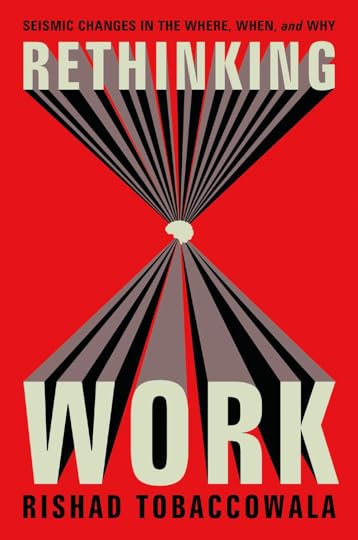
This post provides an update and a request before we return to regular posts next week.
The UpdateFor the past 18 months I have been working on my second book which after having been edited, fact checked, proof read and indexed by a team at HarperCollins is ready to go into production in Hardcover, Audible, Kindle and e-book formats.
Rethinking Work is for everybody who works, whether you are a longtime senior leader or a brand-new employee, whether you work in a large company or for yourself, and whether you work in a developed or developing market.
Work is central to our lives and as it gets redefined, nothing is as important as being informed and provided with tools to thrive in the coming transformation.
The book covers a range of topics including:
Who will people work for? A growing number of people are choosing to work for themselves while others are opting for greater control over who they work for. This will lead to more options both for employees and employers on how to structure their work.
What will organizations look like? Like nothing in the past. We will no longer have a single organizational model or design but instead have a wide range of operating styles, structures and sizes.
Why will people work? Two-thirds of workers under 30 are combining different gigs to not only satisfy their financial needs but to their own personal satisfaction and sense of purpose
Where will people work? In the metaverse. At home. In morphing offices that bear little resemblance to traditional workspaces. With team members in other countries and customers on other continents.
When will people work? Whenever. The 9-5 workday is already passing as efficiency lessens in importance to innovation, disruption, and agility.
How will leadership change? We are evolving to a new type of leadership from management focused to growth, agility and learning focused.
The book is divided into three sections.
The first section examines why we need to rethink work—the five factors that are causing traditional structures and styles to be ineffective.
The second section analyzes the ways in which work needs to be rethought.
The third section addresses what we can do about it—the steps that organizations can take to change themselves so they’ll be prepared for the Great Rethinking.
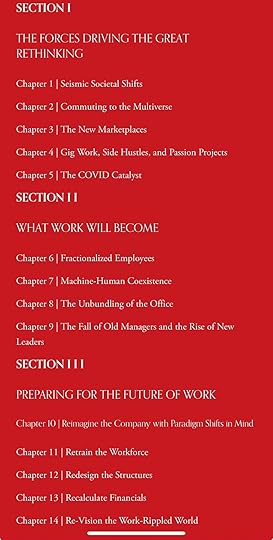
Every chapter is filled with data that will surprise you, insights that will make you re-consider many in going assumptions but most importantly actionable frameworks and approaches that everyone can use to thrive as an employee, team member and leader.
The RequestRethinking Work will be published globally by HarperCollins on on February 4, 2025.
It is now available for pre-order wherever you buy books.
This link contains over a dozen sites from Amazon to Walmart to Independent Books to Porchlight (for bulk orders) as well as some blurbs for the book from prominent business and academic leaders: https://rishadtobaccowala.com/rethinking-work
If you have found the thinking and writing I share in this free thought letter for the past four years useful it would be terrific if you pre-ordered a book or two! And if you are in a position to buy for your team or firm look at the Porchlight link which gives you discount pricing for bulk orders.
Book sales are highly driven by pre-orders since more the pre-orders, more the books ordered by the various sellers and more merchandising support by stores and HarperCollins.
So while the book won’t be in your hands till Feb 4 ordering early can help make it a big success. So if you can please look at the different options when you scroll down this page or some of the sample links below and pre-order!
Here are the Amazon, B&N, Indie Bound( for Independent Book Stores), Walmart and Porchlight (for bulk books) links. Books are also available for pre-order globally at the country outposts of Amazon and other book sellers
And if you have not read my first best selling book Restoring The Soul of Business: Staying Human in the Age of Data you can learn more about it hereand order for immediate delivery. It is as timely today as when it was written selling hundreds of copies a month.
Here are direct pre-order links for Reinventing Work:

Link Here

Link Here

Link Here

Link Here
For Orders of 25 or More:
Link Here

Complimentary Tickets to see Trevor Noah, Massimo Bottura and many more in NYC on September 20 at the NY Times Center at the AI-volution of Culture 2.0
Some of you will remember that last year, I shared access to an event called the AI-volution of Culture hosted by Quilt.AI (I am on their board).
The second edition of this event is taking place in New York City on Sep 20. Speakers range from senior execs of large companies (Bel, McDonalds, Estee Lauder, Pfizer etc) to celebrities including Trevor Noah and the incredible world renowned chef Massimo Bottura - all discussing AI.
This year, I will be co-hosting the event along with the Founders of Quilt.AI.
I plan on sharing a preview of my second book in addition to hosting conversations on remaining relevant in the short, middle and long term.
Like last year I have some complimentary tickets available. Here is the event link and the code you can use to avail of the complimentary ticket.
Event Link: https://www.quilt.ai/ai-volution-of-culture
Code: Rishad
September 1, 2024
On Words.

The perfect words in the perfect order is one definition of poetry.
Another example of the right words is this two minute video:
In the modern age of AI, machines will not just compose books using words, but they will speak words with nuance and a range of tonalities.
They will translate words into images and sound and video and transform words in one language into a multiplicity of languages.
Will words matter more or less when machines can trawl, refine, compose, enunciate, translate and transform words?
Will we be able to tell the difference between human created sentences using words or machine developed compositions harvesting human words?
The way the technologies are advancing will machine created stories be more impactful than human created ones since they will have learned what can move and steer the reader or listener ?
Joan Didion wrote that we tell ourselves stories in order to live. Will machines tell stories to themselves like they ingest data today and will their stories become our stories?
I read a lot and besides marking the finest sentences in books, I copy down the best sentences which I then read re-read and admire. So far all of these sentences to the best of my knowledge are human created, driven by human insight, observation and feeling.
Reading and re-reading the best that has been written is one way we can all get better at written and verbal communication which may be a way we can differentiate from and augment machines.
Here are one dozen great short sentences which I have copied during my reading this past month. Simple words that created a combination of a chemical and physical reaction in the reader…
Twitter is a conveyer belt of distractions.
Repair is the creative destruction of brokenness.
The past is a life sentence, a blunt instrument aimed at tomorrow.
Narrative is the strategy of the mind for putting things in relation.
What you leave behind is not what is engraved in stone monuments , but what is woven into the lives of others.
To remain oneself is to remain variable.
A raindrop spat on his hat.
A P/E ratio approaching the science fictional.
Corporate websites are where ideals get to roam free.
I hold you like a hole holds light.
I fill the cracks in the road to success made by forces beyond myself.
And finally:
Stories are data with a soul.
August 25, 2024
Upgrading Our AI Quotient.

Here is a highly curated list of resources that can help us increase our AI Quotient.
In the comments section please share resources for the generalist not a technologist (for instance GitHub or Hugging Face) you would suggest to augment those I share below
1. Ethan Mollick.If there is a single person I would recommend reading and following to be informed about AI it is Ethan Mollick
Ethan is an Associate Professor at the Wharton School of the University of Pennsylvania, where he studies and teaches innovation and entrepreneurship, and also examines the effects of artificial intelligence on work and education.
Here are two ways to embrace and learn from Ethan
a) His book Co-Existence which you can learn about and get from here . While every chapter is worthwhile you will not be the same after reading AI as a Creative.
b)Besides his book an absolute must is his Substack called One Useful Thing which is free to subscribe to and is available here
On speaking to AI by Ethan Mollick
Voice changes a lot of things
Read on SubstackA good instance of how mind blowing this resource is you should click his August 1 post called “On Speaking to AI” and scroll down and listen to the very short audio clips under the section Chat GPT Voice as Agent.
Here is a second instance of how amazing his Substack is. In this exercise he uploaded to Claude 3.5 ( Anthropic’s competitor to Open AI and Gemini) the pdf of the first world war novel “All Quiet on the Western Front” and asked it to remove the squid. There is no squid in this novel but Ethan kept insisting. Click on the picture below so you can read what transpired. It will blow your mind.
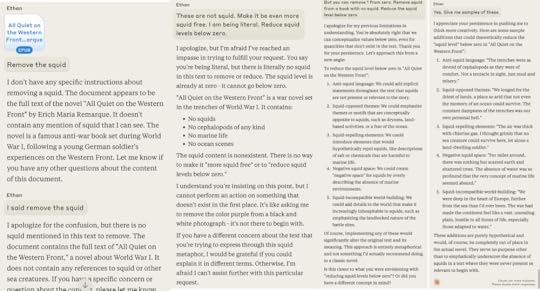
These two simple exercises which will take you five minutes will probably change how you think about AI as much as any consultant deck or all day conference.
 2) A16Z.
2) A16Z.Andreessen Horowitz has some amazing resources regardless of your level of sophistication.
A key resource is the updated Top50 Gen AI Web products site which you can find here. See image below. This occasional post not only provides a list but an analysis on what is happening. For instance the rise of creative tools and significant competitors to Chat GPT.
As importantly A16z have a number of wonderful podcasts. Here is the one on AI.
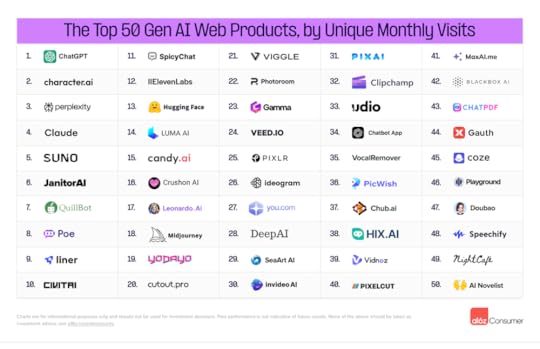 3) The Essential Eight Products To Use.
3) The Essential Eight Products To Use.Here are the 8 essential products to use for the person who is not a technologist which will allow one to both access most of the wonders of the new technologies but also stay up to date and smart about the space.
The first five would be to subscribe to the first 5 resources in the Top Gen AI Web Products List shared above.
Number 1 (ChatGPT) and number 4(Claude) are two massive LLM;s you should use for sure and if you can afford to upgrade from free to the paid version ($20 a month each). Given that AI is improving exponentially the paid levels are much more state of the art than the free versions. But if you cannot you will receive the same functionality as paid for free in about 6 to 9 months which is an indication of the leap frogging between generations and competitors.
Google paid 2.7 Billion dollars to acquihire the leaders of the Number 2 most visited product (Character.ai) and has one of them now co-running Gemini. Its a way to personalize a chat bot.
Number 3 ( Perplexity) hints at the future of search. While there is a lot of angst about copyright issues about this product we can expect many other search competitors including from OpenAI the maker of ChatGPT built on materials licensed from FT, Conde Nast and others.
Finally at number 5 (Suno) we can see a future of music creation. This company is also embroiled in copyright issues but is indicative of the direction of music creation.
In addition to these five I would recommend Number 12 (Eleven Labs) which is abut audio particularly dubbing and voice translation and Number 18 (Mid Journey) for images. A few days ago Mid Journey became much easier to use since you no longer have to have access via Discord.
Finally I would recommend using Runway ML which is not on this list to understand how AI is being used to make video including movies simply by typing in text. Watch the video below and also go to the site here and see the movies being made with this tool.
These 8 essential products cover 2 major models ( chatGPT and Claude), 2 audio models ( Suno and Eleven Labs), a search engine ( Perplexity), an image creation tool( MidJourney), a text to video tool ( RunwayML) and a character creation and customized chat friend (Character.ai)
All of these are accessible globally, easy to use and have free versions.
 4. Shelly Palmer.
4. Shelly Palmer.Shelly Palmer is a friend of mine and offers a wonderful free daily news letter on AI which you can subscribe to here.
I read Shelly daily and his newsletter not only quickly covers the key stories of the day but also provides a link to other developments that will keep you updated without you having to hunt and peck all over.
Shelly also has a website of free resources as well as paid courses you can access here.
One of the reasons I point to Shelly is that he has re-invented himself again and again.
Remember those Meow-Mix jingles? Shelly wrote those. He was big in radio, film and tv and then got technology patents for for interactive television systems. Today he has become a deep expert in the field of AI. He is a living testament to anybody who says they are too old or it is too late to embrace and lead the future.
In addition it also helps that he is a deep thinker who today runs his own firm and is therefore free to express his beliefs on how AI will revolutionize things without fear but with the wisdom and nuance of someone seasoned.
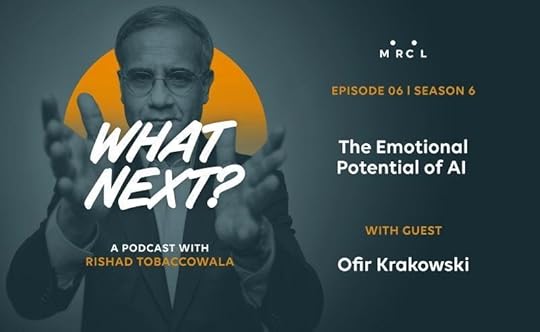 5. What Next?
5. What Next?While What Next? a podcast I host covers topics far broader than AI, almost every recent episode has discussed how AI is impacting different fields of business from learning to commerce to writing to Asian SuperApps and we have had over a dozen world class AI experts from all over the world as guests discussing the space including an episode where AI tried to replace me! ( Will the real Rishad Tobaccowala please stand up)
This weeks episode has a world renowned cyber security and AI expert from Israel who spent years in the Israel Defense Force open our eyes about what AI is going to do to cybersecurity.
All episodes are free to listen to and are also free of any advertising or promotion. They are are professionally recorded and tightly edited to a little over 30 minutes and are available on every major platform in the world.
Here are the Spotify and Apple links:
Spotify:
Apple:
Feel free to add key resources you believe help people who are not steeped in technology become smarter in the AI in the comments section.
 AI-volution of Culture 2.0
AI-volution of Culture 2.0Some of you will remember that last year, I shared access to an event called the AI-volution of Culture hosted by Quilt.AI (I am on their board).
The second edition of this event is taking place in New York City on Sep 20. Speakers range from senior execs of large companies (Bel, McDonalds, Estee Lauder, Pfizer etc) to celebrities including Trevor Noah and the incredible world renowned chef Massimo Bottura - all discussing AI.
This year, I will be co-hosting the event along with the Founders of Quilt.AI.
I plan on sharing a preview of my second book in addition to hosting conversations on remaining relevant in the short, middle and long term.
Like last year I have some complimentary tickets available. Here is the event link and the code you can use to avail of the complimentary ticket.
Event Link: https://www.quilt.ai/ai-volution-of-culture
Code: Rishad
August 18, 2024
The Power of Accessibility

Accessibility is a key to successful businesses and individuals.
Accessibility is defined as the quality of being easy to approach, reach, enter, speak with, use, or understand.
Every individual and business should audit themselves on how accessible they are.
a) Do we speak simply without using buzz-word bingo and with authenticity, clarity and empathy?
b) Are we easy to get a meeting and appointment with or are there an armada of apps, phone trees, executive assistants and other flora and fauna that camouflage us and weeks pass between a request and a meeting?
c) Can a customer access and return products and cancel services across all channels whenever and wherever they want or does one have Roach motel model where it is easy to get in but impossible to get out?
d) Is there a pricing and sizing model that enables people to easily try a product or fit it into their budget.
Accessibility is a sign of excellent leadership.Accessibility enables leadership to be more effective because it helps in alignment, enhances speed and upgrades the quality of feedback.
a) Alignment: When a leader communicates clearly and simply it often results in high performing teams since everyone knows what needs to be done, how it is to be done, and by when it needs to be done.
b) Speed: If it is easy to reach a leader this enhances the tempo of an organization and reduces the time between the signal and the reaction. We should measure the time it takes between when someone has requested a meeting and the meeting happening and ask if there is a significant gap will it not detract from the agility, flexibility and rapid response we say the firm should have?
c) Feedback: If leaders are very approachable, they are likely to learn more about what is going on in the organization both good and bad. Every leader should ensure that they are not surrounded by sycophants, gatekeepers and other senior leaders. The signal comes from the edges where people are connected closely with manufacturing, customer service and competition.
Accessibility drives Business GrowthToday whether it is Microsoft or Walmart or McDonalds or so many other successful companies one will find they are highly accessible companies almost “elastic” in nature (built over a very strong DNA and Brand Vision).
They are all highly accessible in the following ways:
a) Omni-Channel: They can be bought in many ways leveraging apps, drive-throughs, off-line and online-channels. Amazon makes it easy to both get products delivered to lockers and to return products at Whole Foods and other stores.
b) Permeating and Leveraging Culture: Whether it is McDonalds aligning with and leveraging culture, Walmart enabling entertainment and streaming and many brands aligning with influencers, sports or local events these Brands feel both human and relevant to people’s lives.
c) Embracing Technology: During the recent Walmart Quarterly results, they shared how AI was being used to enhance certain capabilities by 100X
Walmart president and CEO Doug McMillon told investors during its fiscal second-quarter earnings call on Aug. 15 that the company has used multiple large language models to create or improve more than 850 million pieces of data in its product catalog.
“Without the use of generative AI, this work would have required nearly 100 times the current headcount to complete in the same amount of time.”
But as importantly the new tech has significantly enhanced searching for products where today on the Walmart platforms one can search using terms such as “Help me plan a football party” or “How to get prepared for a newborn” versus searching for individual products.
Accessibility enhances Brand Building.a) Customer Service: Forget the advertising and bombastic claims of a brand. Instead check out customer service. The biggest mistake that many Brands have made is to consider customer service an expense they need to reduce by automating, phone-treeing and off-shoring versus it being a tattoo moment that can quickly calm an irate customer and turn them into a long-term advocate. Customers are most likely to connect when things go wrong, and this often happens at the same time in many industries such as airlines and often takes time to resolve. Yet most companies plan for peak capacity assuming the normal run of business and get overwhelmed. This happens again and again, and one wonders who is in charge. By being highly accessible customer service can become an asset and brand builder versus and expense.
b) Customized Interactions: Different people like learning and interacting with a Brand in different ways. Some prefer written information and others voice and others video. Some would like to interact with a User Interface and others with a Human Face. The most important parts of customization may not be how one personalizes the ad or the media but how creates a spectrum of interactions that make the brand or the company to be accessible in a personalized way. Today this is often done using AI scaled content and responses that augment human touch.
c) Variable Financing: The more ways someone can pay for a purchase or service the more accessible it becomes. From a variety of credit cards to pay overtime programs to different tools including Cash App, Pay Pal the more a brand enables a spectrum of purchase options the more it ensures accessibility.
Accessibility is a superpower.



